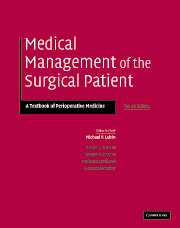Book contents
- Frontmatter
- Contents
- Editor biographies
- List of contributors
- Preface
- Introduction
- Part I Medical management
- 1 Anesthesia management of the surgical patient
- 2 Nutrition
- 3 Preoperative testing
- 4 Chronic medications around the time of surgery
- 5 Ethical considerations in the surgical patient
- 6 Cardiovascular disease
- 7 Postoperative chest pain and shortness of breath
- 8 Perioperative management of hypertension
- 9 Perioperative pulmonary risk evaluation and management for non-cardiothoracic surgery
- 10 Acute lung injury (ALI) and the acute respiratory distress syndrome (ARDS)
- 11 Postoperative pulmonary complications
- 12 Peptic ulcer disease
- 13 Liver disease
- 14 Inflammatory bowel disease
- 15 Postoperative gastrointestinal complications
- 16 Disorders of red cells
- 17 Assessment of bleeding risk in the patient with no history of hemostatic problems
- 18 Surgical issues affecting patients with hemotologic malignancies
- 19 Prophylaxis for deep venous thrombosis and pulmonary embolism in surgery
- 20 Blood transfusion/preoperative considerations and complications
- 21 Prevention of surgical site infections
- 22 Medical care of the HIV-infected surgical patient
- 23 Fever and infection in the postoperative setting
- 24 Surgery in the patient with renal disease
- 25 Postoperative electrolyte disorders
- 26 Diabetes mellitus
- 27 Disorders of the thyroid
- 28 Disorders of the adrenal cortex
- 29 Disorders of calcium metabolism
- 30 Pheochromocytoma
- 31 Rheumatologic diseases
- 32 Cerebrovascular disease
- 33 Management of the surgical patient with dementia
- 34 Neuromuscular disorders
- 35 Perioperative management of patients with Parkinson's disease
- 36 Delirium in the surgical patient
- 37 Surgery in the elderly
- 38 Obesity
- 39 Depression
- 40 Substance abuse
- 41 Care of the peripartum patient
- Part II Surgical procedures and their complications
- Index
- References
38 - Obesity
Published online by Cambridge University Press: 12 January 2010
- Frontmatter
- Contents
- Editor biographies
- List of contributors
- Preface
- Introduction
- Part I Medical management
- 1 Anesthesia management of the surgical patient
- 2 Nutrition
- 3 Preoperative testing
- 4 Chronic medications around the time of surgery
- 5 Ethical considerations in the surgical patient
- 6 Cardiovascular disease
- 7 Postoperative chest pain and shortness of breath
- 8 Perioperative management of hypertension
- 9 Perioperative pulmonary risk evaluation and management for non-cardiothoracic surgery
- 10 Acute lung injury (ALI) and the acute respiratory distress syndrome (ARDS)
- 11 Postoperative pulmonary complications
- 12 Peptic ulcer disease
- 13 Liver disease
- 14 Inflammatory bowel disease
- 15 Postoperative gastrointestinal complications
- 16 Disorders of red cells
- 17 Assessment of bleeding risk in the patient with no history of hemostatic problems
- 18 Surgical issues affecting patients with hemotologic malignancies
- 19 Prophylaxis for deep venous thrombosis and pulmonary embolism in surgery
- 20 Blood transfusion/preoperative considerations and complications
- 21 Prevention of surgical site infections
- 22 Medical care of the HIV-infected surgical patient
- 23 Fever and infection in the postoperative setting
- 24 Surgery in the patient with renal disease
- 25 Postoperative electrolyte disorders
- 26 Diabetes mellitus
- 27 Disorders of the thyroid
- 28 Disorders of the adrenal cortex
- 29 Disorders of calcium metabolism
- 30 Pheochromocytoma
- 31 Rheumatologic diseases
- 32 Cerebrovascular disease
- 33 Management of the surgical patient with dementia
- 34 Neuromuscular disorders
- 35 Perioperative management of patients with Parkinson's disease
- 36 Delirium in the surgical patient
- 37 Surgery in the elderly
- 38 Obesity
- 39 Depression
- 40 Substance abuse
- 41 Care of the peripartum patient
- Part II Surgical procedures and their complications
- Index
- References
Summary
Introduction
The increasing prevalence of obesity among adults and children, new insights into the pathogenesis of obesity, and significant changes in the practice of surgery through adoption of less traumatic laparoscopic approaches, all justify up-dating this chapter from the third edition (published in 1995, containing references through 1993).
Prevalence
The age-adjusted prevalence of obesity was 30.5% in 2000 according to a national examination survey, while the prevalence of overweight was 64.5%. The largest telephone survey in the USA reported a prevalence of 20.9% for obesity in 2000 giving an indication of the validity of telephone surveys related to this topic. Regardless of their relative validity, all studies unequivocally document disturbingly rapid yearly increases (P < 0.001) in obesity and overweight and their related serious diseases: diabetes, hypertension, dyslipidemia, asthma, etc. Class 3 obesity (BMI ≥ 40) tripled from 1990 to 2000, reaching a prevalence of 6% among black women, causing the authors of the study to conclude: “the incidence of various diseases will increase substantially in the future.” Increasing prevalences of childhood and adolescent overweight and obesity are especially troubling: adolescent overweight is a strong predictor of adult illness.
Two large epidemiological studies published in January 2003 comprising 3457 subjects (The Framingham Heart Study) and 23 659 subjects confirmed that obesity and overweight in adulthood markedly decrease life expectancy. Fontaine et al. determined that younger adults generally had greater number of years lost than did older adults and Peeters et al. found the decreases in life expectancy to be comparable to those seen with smoking.
- Type
- Chapter
- Information
- Medical Management of the Surgical PatientA Textbook of Perioperative Medicine, pp. 465 - 478Publisher: Cambridge University PressPrint publication year: 2006

